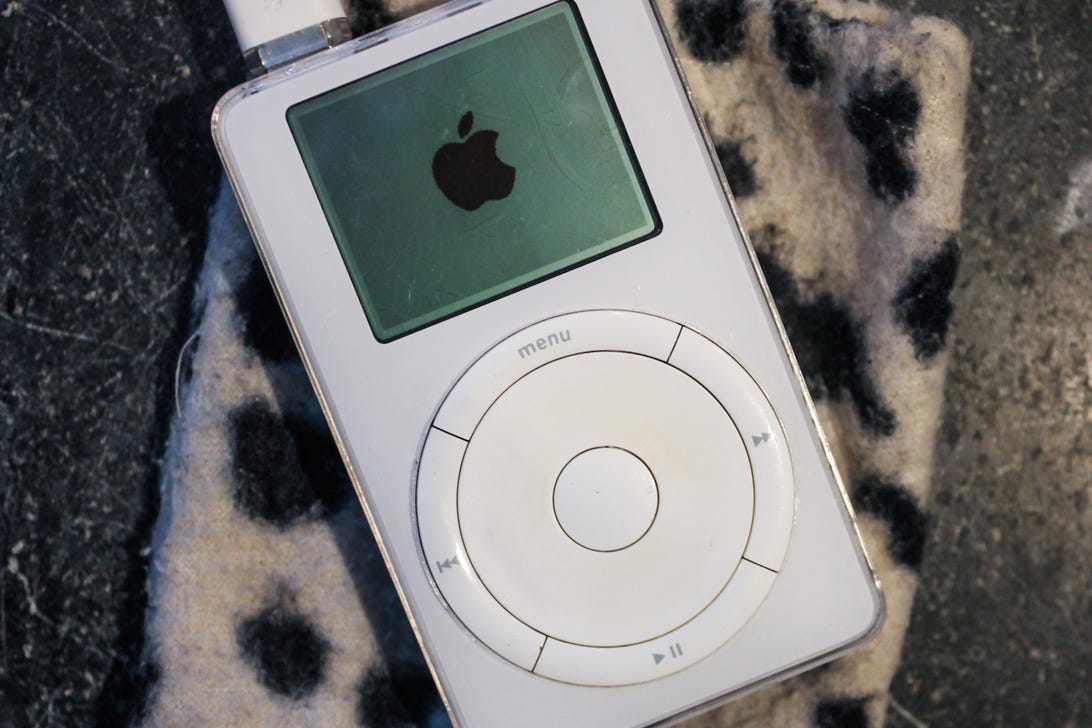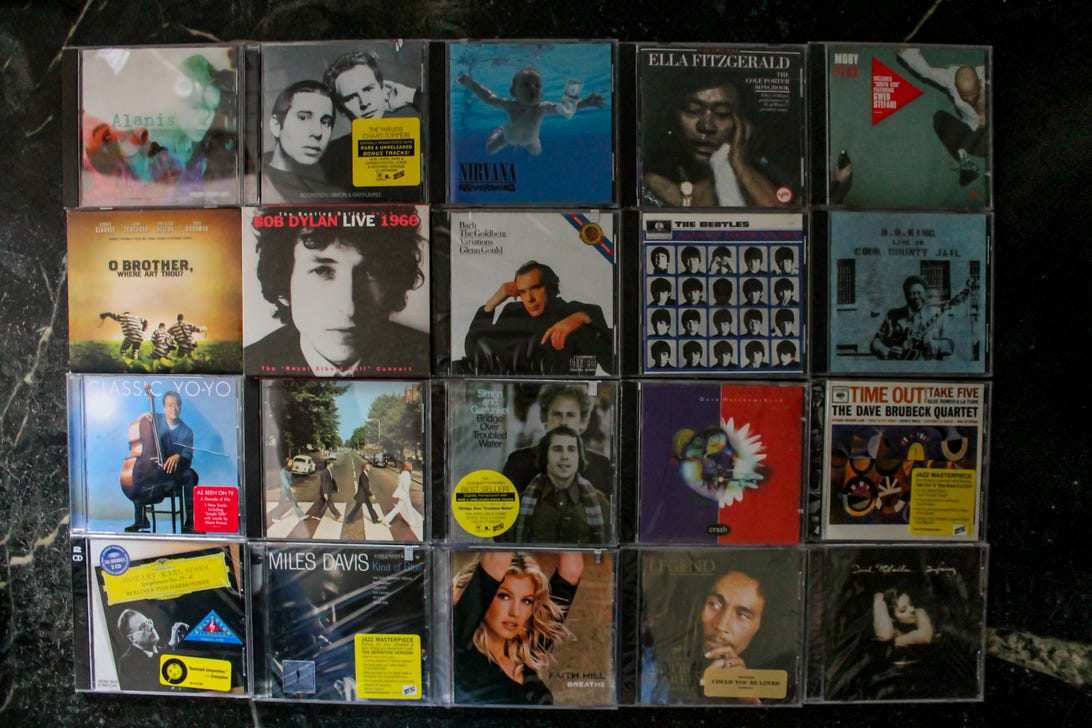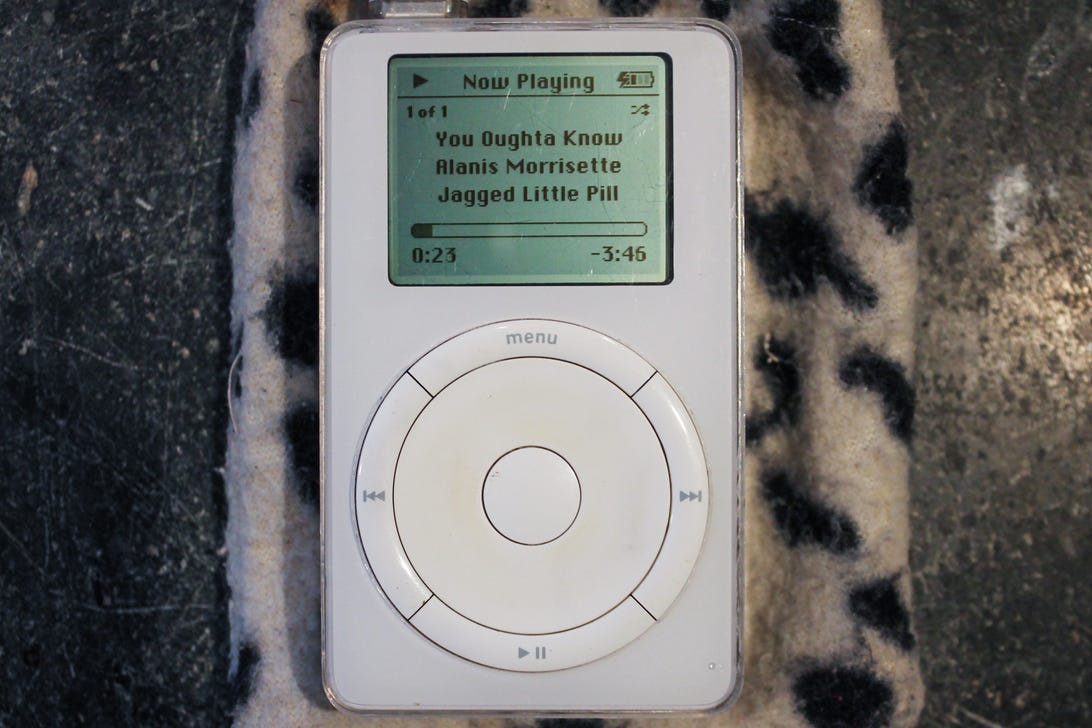
The original iPod. Twenty years later, it still works.
Connie Guglielmo/CNETThis is what I remember: There was a line to get into Apple's headquarters to see Steve Jobs.
That wasn't all that unusual. Apple's CEO was the closest thing the tech industry had to a rock star. Like him or not, he was a charismatic and persuasive presenter who could make even the most mundane tech sound like it was the next great thing, something you didn't even know you wanted. So it wasn't a surprise the media queued up to hear whatever Jobs had to say.
But on the morning of Oct. 23, 2001, the buzz was different. Apple, best known as the maker of Macintosh computers, was about to take one of the biggest risks in its history, something that would eventually make the company into the powerhouse consumer electronics juggernaut it is today. After less than a year of development, Jobs announced something completely different for Apple: a digital music player.
It may not sound like a big deal, but this was the precursor to the iPad and Apple's all important iPhone, products that have turned out to be the drive behind its $2.5 trillion dollar valuation. As we celebrate the 20th anniversary of the iPod's introduction, it's worth remembering just how big a risk it was for Apple. Even Tony Fadell, the man credited as the "father of the iPod," admits they weren't sure the device would be a hit.
"There were a lot of 'Holy shit is this going to work?' kind of moments," Fadell said in an exclusive interview last week with CNET News Editor Roger Cheng. "We really didn't know."
Neither did the members of the media who packed into Apple's conference center that launch day. The rumor was Jobs would announce an MP3 digital music player, with the invitation for the event fueling all the speculation because it read: "Hint: It's not a Mac." Jobs unveiled the iPod in a presentation that lasted about an hour, and in typical fashion, he wove in a story about why Apple's big gamble wasn't a risk at all, by starting with an emotional pitch.
"We love music, and it's always good to do something you love," Jobs, dressed in his trademark jeans and black mock turtleneck, told the audience as he paced back and forth across the stage.
"Music's a part of everyone's life -- everyone. Music's been around forever. It will always be around. This is not a speculative market. And because it's a part of everyone's life, it's a very large target market, all around the world. It knows no boundaries. But interestingly enough, in this whole new digital music revolution, there is no market leader."

To avoid accusations of music piracy, Apple had to give me the physical CDs for the 20 albums stored on the iPods we received.
Connie Guglielmo/CNET'1,000 songs in your pocket'
He wasn't wrong. There were a few companies -- most notably Creative Labs -- with MP3 players, but their devices hadn't caught on, in part because they were clunky, expensive and not all that easy to use. Jobs was counting on the fact that Apple, known for its stylized hardware and intuitive software, could create a player that its loyal Mac users would buy. And he touted the iPod's elegant and ultra-portable hardware design, the piezoelectric clicker built into the scroll wheel that let you navigate with one hand, the 1,000 songs the 5-gigabyte device could hold, the 10-hour life of the rechargeable lithium-ion battery, and the iTunes 2 software that automatically synced the iPod with the music library stored on your Mac.
Oh, and he also mentioned that the device, which used Apple's high-speed FireWire file transfer tech, could be turned into a portable hard drive for any files stored on your Mac.That was an important part of his sales pitch. The iPod was pricey at $399 (about $616 in today's dollars) -- and especially when you consider that a CD player cost about $75 at the time. So Jobs made a point of noting the return on investment for the device, as both a hard drive and CD player replacement.
But his big takeaway, the phrase that would dominate headlines: "1,000 songs in your pocket."
Here's exactly what Jobs said about the iPod -- and I'm including the tech specs and leaving in the repetitive comments he used because they're part of his salesmanship and storytelling charm:
If we're going to keep 1,000 songs on iPod and it fits in your pocket, how do we do this? How do we possibly do this?
A big breakthrough -- Apple's legendary ease of use applied to a consumer electronics device.
We start off with an ultra thin hard drive. We've got a 1.8-inch diameter hard drive that's 0.2 inches thick -- super thin. And that hard drive is five gigabytes in capacity -- 5 gigabytes -- which holds 1,000 songs at a 160-kilobit rate, which is a very high quality rate of MP3 compression. Very high quality. 1,000 songs on this 5-gigabyte drive. And we built in 20-minute skip protection. That's not 20 seconds -- 20-minute skip protection, so you can take iPod bicycling, mountain climbing, jogging, you name it, and you're not going to skip a beat.
So we got this 5-gigabyte drive, it holds 1,000 songs. How do we get the 1,000 songs onto iPod? We don't want to wait. So we've built in FireWire. Now Apple as you know invented FireWire. We ship FireWire on every computer we make. It's built into iPod. It's the first and only music player with FireWire. Why? Because it's fast; you can download an entire CD in the iPod in five to 10 seconds. An entire CD. ...
It's the size of a deck of cards. A deck of cards. It is 2.4 inches wide, it is 4 inches tall and it is barely over three quarters of an inch thick. This is tiny. It also only weighs six and a half ounces -- that is lighter than most of the cell phones you have in your pockets right now. ...
So this is iPod. Playlists, artists, songs settings. Very, very simple -- a breakthrough in consumer electronics user interfaces. The scroll wheel lets us not only rapidly find our music, but lets us use iPod with one hand. ... We think we got a breakthrough in user interfaces to where it is now accessible to everybody to have 1,000 songs and find them and navigate them faster than If you only have 10 or 15 on a much simpler device. A big breakthrough -- Apple's legendary ease of use applied to a consumer electronics device.
A nail biter
Jobs did the demos himself, sitting at a Mac connected to an iPod, with the interface projected onto the stage screen. At one point, his fingers appeared on the scroll wheel and he laughingly acknowledged he bit his nails and should have called on a nail artist. Then he played a selection from the 215 songs stored in his iTunes music library.
The first song ever played in public on the iPod? Sarah McLachlan's Building a Mystery.
Jobs followed it up with Could You Be Loved by Bob Marley, Yo-Yo Ma's Bach Prelude, Cello Suite No. 1 from his Classic Yo-Yo album, and The Beatles' I Should Have Known Better from A Hard Day's Night. Watch the presentation and you'll hear Jobs sing along with The Beatles -- twice (he also sings along to the opening of If I Fell in Love With You).
The crowd was mesmerized, especially with Jobs' real-time demo of how long it took to transfer songs from his Mac onto a blank iPod. Jobs actually counted out progress. "What it's doing is it's going to my music library and it's downloading every single song. And you can see how fast it's going. It's really fast. It's already downloaded 24 songs, 26 songs, 30 songs. It's already filled up 190 megabytes on my iPod. This thing's fast!," he said, and the audience laughed. "We're just going to wait a few minutes -- I've got about 215 songs. This will take well over an hour on a USB player, and it's going to take us under two minutes here."
After the songs uploaded, I remember whispers of "That's cool" echoing among the reporters in the back rows where I sat.
As with most Apple events, the demos were interspersed with videos, including Apple's design chief Jony Ive talking about how the design came together. There were also testimonials from musicians Moby and Seal.
"It doesn't take a rocket scientist to figure this out, and I ain't no rocket scientist," Steve Harwell, lead singer of Smash Mouth, said as his song All Star played. "You've got your own record store on this damn thing. This kicks every other product's ass."

Alanis Morissette's defining 1990s album Jagged Little Pill was preloaded on our iPods. I made the case myself (Jobs was not amused when I mentioned I wanted one).
Connie Guglielmo/CNETNo case
When he finished the presentation, Jobs told all of us in the audience we'd be going home with an iPod, preloaded with music from 20 of his favorite CDs (the list is below.) And because there wasn't a way to buy digital music in those days, he gave each of us a shopping bag filled with the physical CDs so as not to be accused of music piracy.
I ran into Jobs in the demo room that day and asked him if he'd thought about creating a case for the iPod. He looked at me and narrowed his eyes. "What for? It fits in your pocket." I gestured to the pocketless skirt I was wearing and said, "Some of us don't carry things in our pocket -- we put them in our purses. This thing is going to get scratched in there." He just narrowed his eyes at me again and walked off.
I handed off my iPod and the bag of CDs to my husband when I got home (he thought it was cool -- as did the line of neighbors who showed up at our door to try it out over the next week). I headed to my sewing basket, pulled out some black-and-white fabric and sewed a rectangular sack with a drawstring. Like I said, I didn't want the white coating on the front and the shiny aluminum back of the chassis to get scratched.
I listened to that iPod pretty much every day for the next 10 years, replacing it over time with an iPod Mini (mint green) because it was even smaller, with a higher-capacity drive. Twenty years later, I pulled out my pristine version 1.0 iPod from my drawer for the first time in at least half a decade and turned it on. It didn't power up until I plugged it in using the original charging cable. I lost the earbuds a long time ago, but the speaker jack works just fine and all the music is still there -- along with that satisfying click wheel. It's still as cool as the day I got it.
I was already a Mac fan 20 years ago (my first job in tech journalism was at a startup weekly called MacWeek). So If you'd asked me then if I thought the iPod would be a success, I would've said yes, if only because it was so easy to use. But not everyone was convinced and as Fadell notes, it took a while for the iPod to be a strong seller for Apple. By 2007, a little more than five years after that original launch, Apple sold its 100 millionth iPod. The business peaked in 2008 with sales of 54.8 million units, according to Statista. Today, Apple sells only one model of the iPod -- the iPod Touch, as CNET's Ty Pendlebury notes -- since most people like me now rely on their iPhone as their music player.
But two decades ago on Oct. 23, Jobs was nothing but confident that Apple and the iPod would shake up the industry. He closed the event in his again typical, not-so-modest fashion.
"There's been nothing like this before. And I don't think there's another company that could do this. To bring the hardware design, the industrial design, the application software design, FireWire -- everything -- under one roof, together. To be able to create a product like this, it's pretty amazing."
20 albums on an iPod
Jobs selected these 20 albums to put on the iPods he gave out at the event. We got the CDs, too. To hear the albums for yourself, have a listen to this Spotify playlist.
- Abbey Road by The Beatles
- Bach: The Goldberg Variations by Glenn Gould
- Legend by Bob Marley & The Wailers
- Bob Dylan Live 1966: The "Royal Albert Hall Concert"
- Bookends by Simon & Garfunkel
- Breathe by Faith HIll
- Bridge Over Troubled Water by Simon & Garfunkel
- Classic Yo-Yo by Yo-Yo Ma
- Crash by The Dave Matthews Band
- Ella Fitzgerald Sings the Cole Porter Songbook
- A Hard Day's Night by The Beatles
- Jagged Little Pill by Alanis Morissette
- Kind of Blue by Miles Davis
- Live in Cook County Jail by B.B. King
- Mozart Symphonies Nos. 35-41 by Karl Bohm and the Berlin Philharmonic
- O Brother, Where Art Thou? Soundtrack
- Nevermind by Nirvana
- Play by Moby
- Surfacing by Sarah McLachlan
- Time Out by The Dave Brubeck Quartet
https://ift.tt/3vF9WmZ
Bagikan Berita Ini














0 Response to "What it was like to watch Steve Jobs introduce the iPod 20 years ago - CNET"
Post a Comment